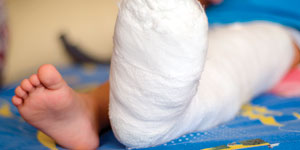Toddler
4 min Read
Why trampolines aren’t all fun and games

September 21, 2017
Toddler
4 min Read

September 21, 2017


Kids love to bounce. It’s in them. Someone, somewhere took notice and now, trampoline parks are popping up all over the place. And that means that trampoline injuries are on the rise. While jumping the day away seems like innocent fun, parents should be aware of the risks involved and the safety precautions required, especially for toddlers.
Simply landing the wrong way can cause serious, permanent injuries. “We’re concerned, not only with the increase in trampoline-related injuries, but the severity of those injuries,” said Dr. Claire LeBlanc, chair of the CPS Healthy Active Living and Sport Medicine Committee. “Children often break bones or dislocate joints and frequently require surgery. Head injuries are also common, and in some cases injuries to the neck or back can cause paralysis or death.”
You think you are being safe, but injuries can happen even when a trampoline has a net and padding, and parents are watching. In fact, recent studies have shown that most trampoline injuries happen at home and children younger than six are at the greatest risk. With bones that are not yet fully developed, youngsters are not equipped for continuous bouncing and are more prone to injury.
Carrie Lawton and her three-yearold daughter Mae know firsthand that trampolines can pose a huge risk for toddlers. “My friend and her son came with my daughter Mae and I to a trampoline park, and when I heard they had a toddler time I didn’t think twice about her safety,” says Carrie. “I jumped on the trampoline while Mae was in the air and she came down twisting her ankle…or so I thought.”
When Carrie heard Mae’s cry, she knew something was seriously wrong. A trip to the emergency room and a few x-rays later, it was determined that Mae had a buckle fracture and required a splint. Carrie says she felt like a failure for not knowing more about trampoline safety and for putting her daughter at risk.
Recent statistics from the Public Health Agency of Canada reported that there were 4,247 documented cases of trampoline injuries treated in emergency rooms across 15 hospitals between 2005–2006 and 2009–2010.
According to healthychildren.org, some of the most common trampoline-related injuries include:
Most trampoline injuries occur when there are multiple people using a trampoline and kids can get hurt when they:
As a parent who’s been through it, Carrie warns other parents about the dangers of trampolines. She suggests that the best ways to protect kids, teens and parents are education and information. “Read up about the age requirements for children and trampolines, and really pay attention to the pros and cons,” says Carrie. While Mae’s accident was minor, it was serious enough for Carrie to know that trampolines aren’t all fun and games.
Originally published in ParentsCanada magazine, Fall 2017.